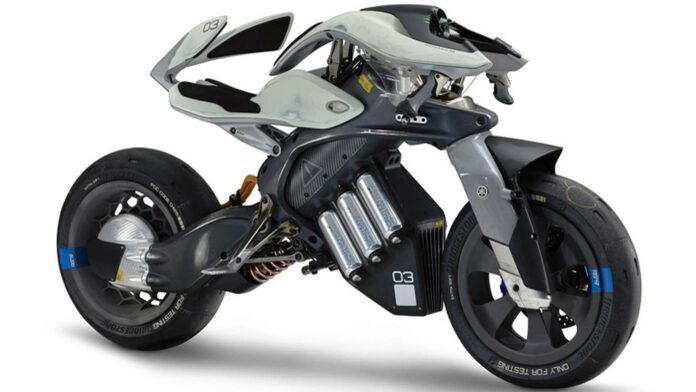Yamaha Motoroid2
Yamaha’s demonstration of the Motoroid2 at the Japan Mobility Show 2023 indeed captures a vision of future mobility that blends advanced technology with a sense of personal connection and interaction.
Here’s a breakdown of the various aspects and queries you mentioned:
- Interaction and Recognition Capabilities:
- The Motoroid2’s ability to recognize its owner and interact like a “living creature” signifies a leap in AI and machine learning, reflecting advancements in personalization and human-machine interaction. This evolution could profoundly influence how users interact with their vehicles, creating a more intuitive and engaging experience.
Japan Mobility Show 2023
- Dance Routine Demonstration:
- By choosing a dance routine for the demonstration, Yamaha seems to emphasize the fluidity, precision, and adaptive capabilities of the Motoroid2. This creative approach highlights not just the machine’s technical capabilities but its ability to partake in human-like activities, enhancing its appeal as a companion rather than just a vehicle.
- Translucent Blue Protective Plastic:
- The blue plastic could indeed be for protective reasons, common with new products to prevent scratches or damage. However, given the setting, it could also contribute to the vehicle’s aesthetic, matching the rider’s gear and maintaining a futuristic, cohesive visual theme.


Self-balancing
- “Personal Mobility Concept” vs. Traditional Motorcycle:
- Labelling the Motoroid2 a “personal mobility concept” indicates Yamaha’s vision extending beyond traditional motorcycles. It suggests a future where vehicles are not just about transport but also about companionship, adaptability, and an extension of the user’s personality and life. Its self-balancing technology, among other features, points to innovations that enhance safety, balance, and possibly even accessibility for new riders.
Artificial Intelligence
- Control During the Demonstration:
- The scene you described where it’s ambiguous whether the rider or a person off to the side is controlling the Motoroid2 highlights an interesting intersection between manual and remote operation. It’s possible that, for safety and accuracy during a public demonstration, external control or guidance is used. However, the broader implication is fascinating: there could be a future where vehicles are operable both manually and remotely, enhancing usability and offering novel applications of personal mobility.
Human-Machine Interaction
- Future of Mobility:
- Is this the future of mobility? It appears Yamaha is proposing a direction where technology makes vehicles more interactive, safer, and more integrated into users’ lifestyles beyond being mere transportation tools. While it’s a concept, the reality will depend on practical considerations like affordability, infrastructure, regulatory acceptance, and actual user experience and benefits.
Yamaha’s Motoroid2 stirs a conversation about future mobility, inviting both excitement and scepticism. While some may see this as a thrilling evolution, bringing us closer to our machines, others might question its practicality and applicability in everyday life. As with all technology, it needs to resonate with real-world benefits to find acceptance beyond the spectacle of exhibitions.
Conclusion
Yamaha’s Motoroid2 represents a bold step into the future of mobility, blending technological innovation with a personalized user experience. It transcends the traditional concept of motorcycles, promising a future where vehicles are not merely a means of transportation but also interactive companions capable of enhancing our lifestyle.
The demonstration, with its unique dance routine and advanced interactive features, is a testament to the evolving relationship between humans and machines. It challenges our current perceptions and invites us to envision a future where our vehicles understand and respond to us, contributing more intimately to our daily lives.
However, this vision of future mobility raises essential questions and considerations. Practicality, affordability, safety, and regulatory acceptance stand as significant hurdles that must be addressed before such advanced vehicles become an integral part of our daily lives. Moreover, the technology’s real-world applicability will be a crucial determinant of its success beyond the controlled environment of exhibitions and demonstrations.
As we stand on the brink of this technological evolution, the Motoroid2 encourages a dialogue regarding our readiness and willingness to accept a new era of mobility. The concept’s reception and subsequent development will depend on how it resonates with consumers’ needs and the holistic benefits it brings to the societal landscape of transportation.





































